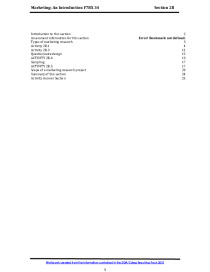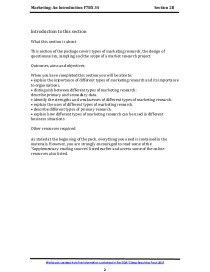Marketing Research For Business



Introduction to this section. Assessment information for this section. Types of marketing research. Activity 2B. Questionnaire design. Activity 2b. Sampling. Activity 2b. Scope of a marketing research project. Summary of this section. Activity Answer Section.
As stated at the beginning of the pack, everything you need is contained in the materials. However, you are strongly encouraged to read some of the ‘Supplementary reading sources’ listed earlier and access some of the online resources also listed.
Marketing research is a method and a series of tools and techniques that help businesses provide the right products or service, in the correct place at the right time to meet demand. Research helps a business reach the right marketing mix decisions that are right for their markets and their business operations, both online or offline.
There are three major types of research which can be undertaken depending upon the information you require.
Field research is done first hand and is a primary method of research.
Desk research can be helpful as it has already been done and search from the office or desk environment. With this information, a business can react quickly to changes in the market conditions. However, information may be biased and could lead to the wrong decisions being made (misinformation). Not being reliable information it may have been collected before for another reason so is not fit for current purpose.
Field research can be done by personal interviews, telephone surveys, online survey and postal surveys, focus groups, observations, sampling, electronic point of sale. They can find out examples of consumer buying.
The information is relevant linking back directly to products and services. Gathered for specific purposes, and is up to date.
There are also some disadvantages of this method as it can be costly and time consuming, wide selection of people must be interviews for a realistic viewpoint. The information gathered has to be analysed and interpreted after collection. The questions worded in a certain way can influence an answer.
These can be collected by organisations in many ways such as government statistics such as which can indicate social and economic trends including the census.
Other methods depending on the type of business might include the use of questionnaires, surveys that identify customer preferences, these could be useful to a restaurant or café to help identify customer preferences and experience while at the premises and to collect ideas for future products or services.
Focus groups can be a good indicator to a business on new products for example a bakers might create new products and require a focus group to sample the products to talk about textures, flavours , size, content, smell, variety and more. This will help identify at an early stage if a product is worthwhile investing in and if changes are required. Of course, through focus groups this would also open up discussion for price, environmental issues such as packaging or health benefits.
Primary research, also known as field research, consists of obtaining information that previously did not exist. It is obtained by going out into the marketplace (the ‘field’) and carrying out some sort of investigation there. Sampling of large populations is the norm and typically some sort of questionnaire is used with the results collated and analysed statistically in order to draw conclusions from the responses. Although the results obtained from primary research will fill the information gap, the main drawbacks are expense and the time taken to carry out the research.

















